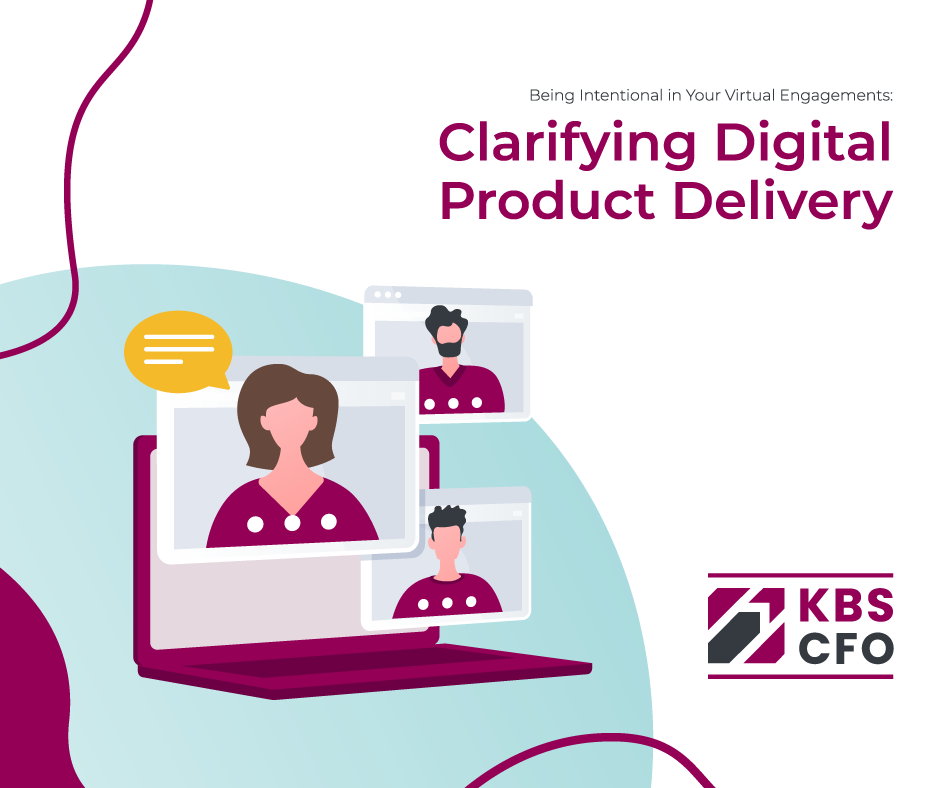Blog

Intentionality in Virtual Work: Clarifying Digital Product Delivery
I had the pleasure of speaking at the Digital CPA conference as a co-presenter with Kevin Cumley. Mr. Cumley was recently named one of the top 100 influencers in accounting. At the conference, I talked about the role of the digital CFO to keep clients and employees engaged, connected, and productive in a system that might be completely different than what the client and workplace are used to.
As an anticipatory CFO, I built KBS into a virtual organization over 15 years ago, before most businesses had even heard of cloud computing. I chose to be an early adopter of virtual technology for the workplace and learned through experience what works for an efficient remote office and what doesn’t.
One regular stumbling block I run into in running a virtual business is the issue of digital product delivery. Digital products, or virtual deliverables, are anything that isn’t tangible—in my business, that includes completed reports, finished software setup, or a year of books that are ready to be submitted to the IRS. Everyone on the team must know when a deliverable is completed, delivered to the client, received, approved, or returned for changes. The whole process needs to be clear to the client and my team.
What are the Expectations of Digital Product Delivery?
- Confirming and proving delivery of the goods to the client.
- Secure, appropriate methods for the customer to acknowledge receipt of the goods.
- Helping the client stay informed and aware of the creation process and what goes into the product.
- Verifying approval of the product by the client.
- Proper record keeping for both seller and client.
What Problems Occur with Delivering Virtual Goods?
Without reliable virtual delivery methods, it’s easy to lose track of where a digital product went. If the seller cannot prove delivery and receipt, the client can make claims against the seller. The cost of a mistake with virtual deliverables can include litigation, lost relationships, lost time, negative reviews, and adverse effects on both the seller and the client’s workflow.
You usually get proof of shipping and delivery with tangible goods, like tracking numbers and photos of the package left on the buyer’s doorstep. However, virtual deliverables aren’t so simple. The seller must provide proof of completion, delivery, and receipt for their records, the client’s records, and any authorities needing to view them.
Some points of information that virtual sellers collect for proof of digital product delivery:
- E-signatures.
- Virtual shipping receipts.
- Verification of product specifications.
- IP addresses.
- Notifications triggered by the client accessing the product.
Some sources for problems with virtual deliverables are:
- Scattered communication threads.
- Not having clearly defined roles on projects.
- Not having or sticking to a timeline.
- Not having the proper storage and transmission methods.
- Accidents and mistakes.
- The seller attempting to defraud the client.
- The client attempting to defraud the seller.
What Can You Do to be Intentional about Virtual Interactions with Clients?
Virtual deliverables are so much easier when you have created the right environment. Then, at some point, it actually becomes natural. Here is what you need:
Definitive Roles In Digital Product Delivery Projects
Have definitive roles in projects. Make sure the client knows who they’re communicating with about what. A project manager should be able to make decisions about the elements, methods, and direction of the project. This person should monitor the team’s progress and be dedicated to exceeding the client’s needs.
Proper Communication Methods
Have the right communication platforms and practices to keep the team, and the client informed and on track. For example, email is not suitable for monitoring projects. Instead, you need a hub that everyone involved can use so inboxes don’t get clogged up with endless threads.
Stay on topic with your meetings, so they don’t get scattered and off focus. Be aware of what a message should contain, what kind of conversation would benefit from a phone call, and what needs a video call.
Keep it step by step. Taking an incremental approach keeps everyone connected and lets the client see how their project is coming along and what goes into it. Project management programs designed for this purpose can monitor numerous projects from initial request to follow-up after delivery.
Listen To Your Client’s Needs
Consider the client’s industry. Do they adapt well to remote work, or will they need extra help? For example, we often work with distilleries and construction companies. Because our distillery clients are so rooted in their facility, we know that they are less able to leave their office. Construction clients, on the other hand, rarely sit at their desks and are thus more comfortable with being more virtual.
The last but most essential thing to do is listen and observe. People will often show you needs that need filling in ways you weren’t expecting. Listen to everyone’s input. Now is the time to make them feel more seen and heard.
Always Look For Ways to Raise the Bar!
I built my career on proactivity. Starting in the early years of virtual accounting, I’ve created efficient systems for my clients long before many organizations went virtual in product management and delivery.
A digital CFO can create strategies for any industry to exceed their and their clients’ needs. At the conference, I shared my experience as an anticipatory CFO to teach attendees how to sharpen their skills with system-based solutions that adapt perfectly to their workplace. Contact KBS CFO to learn more.
